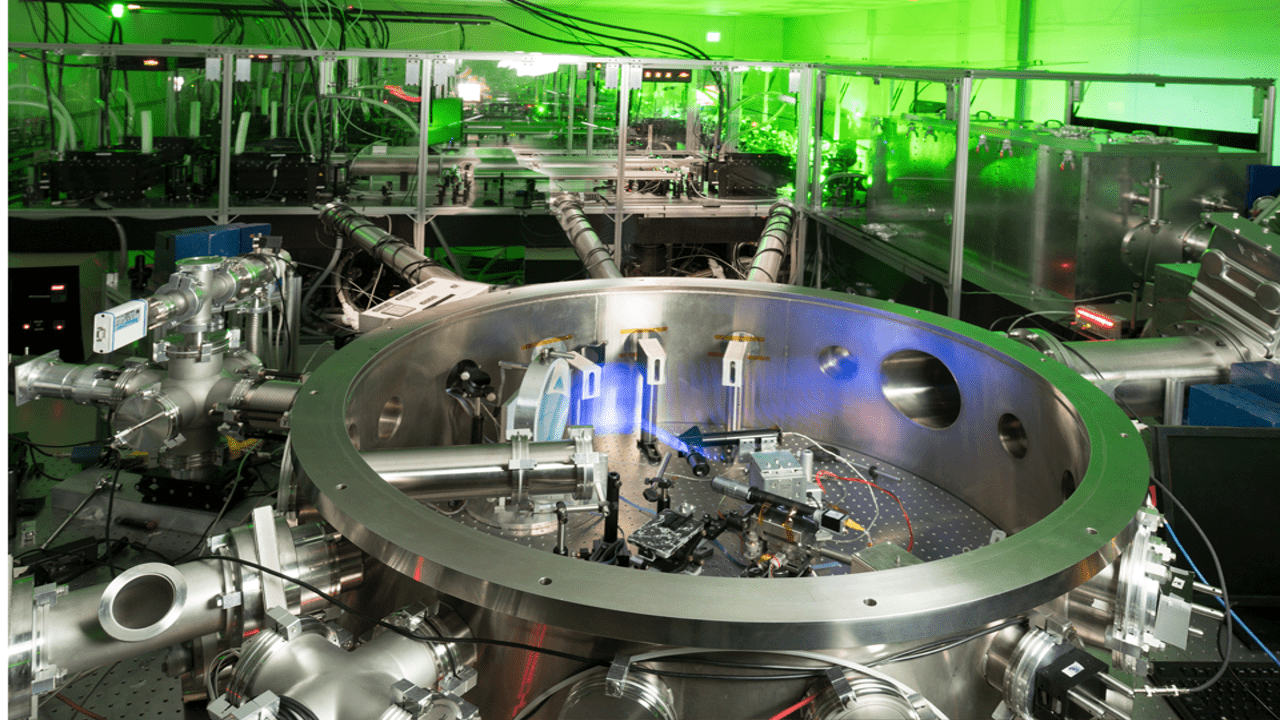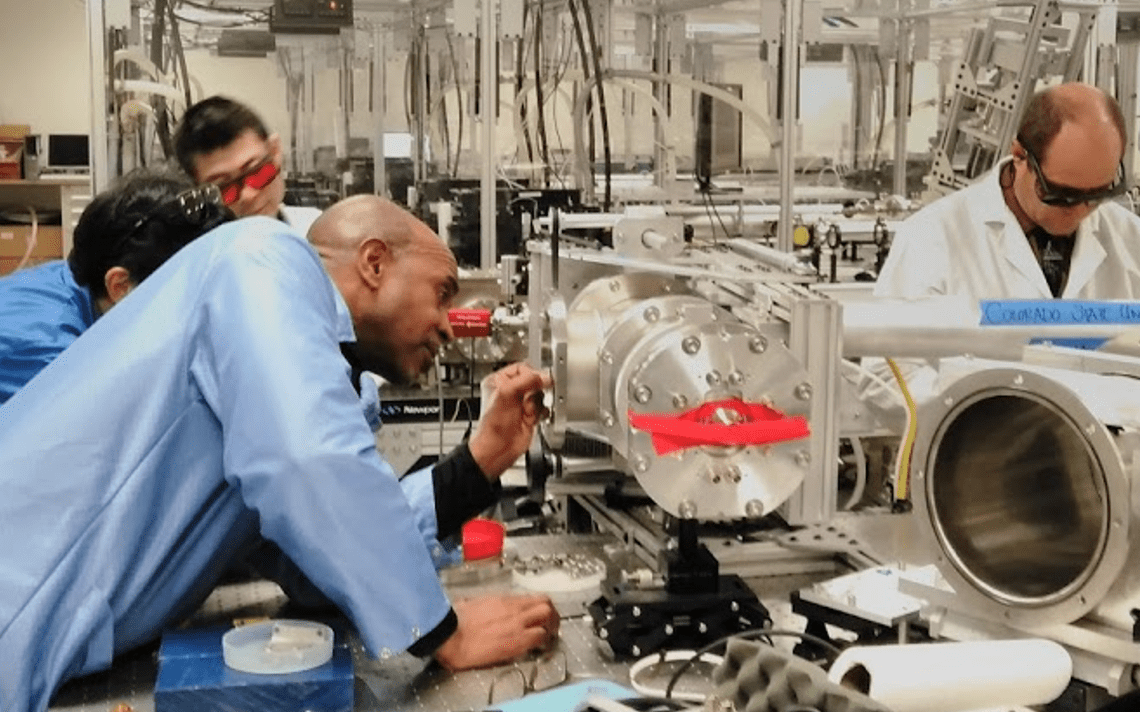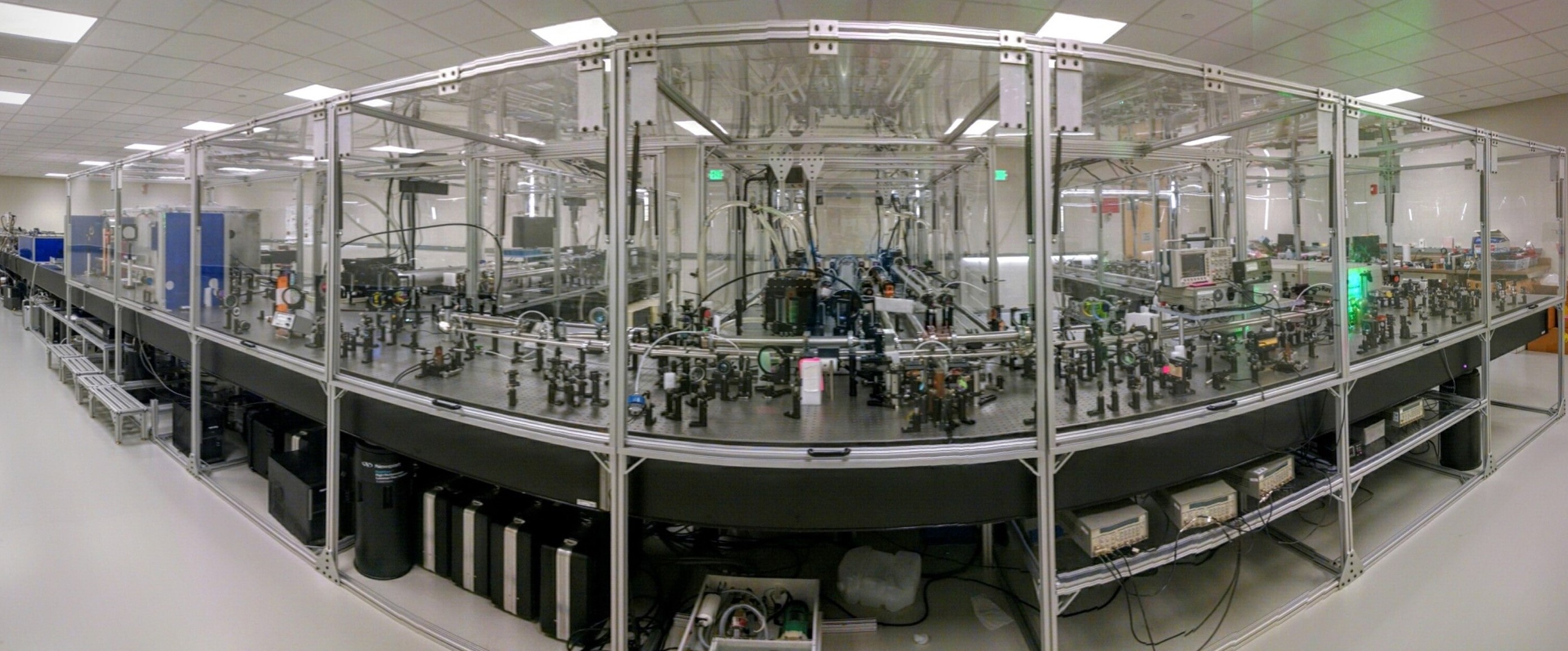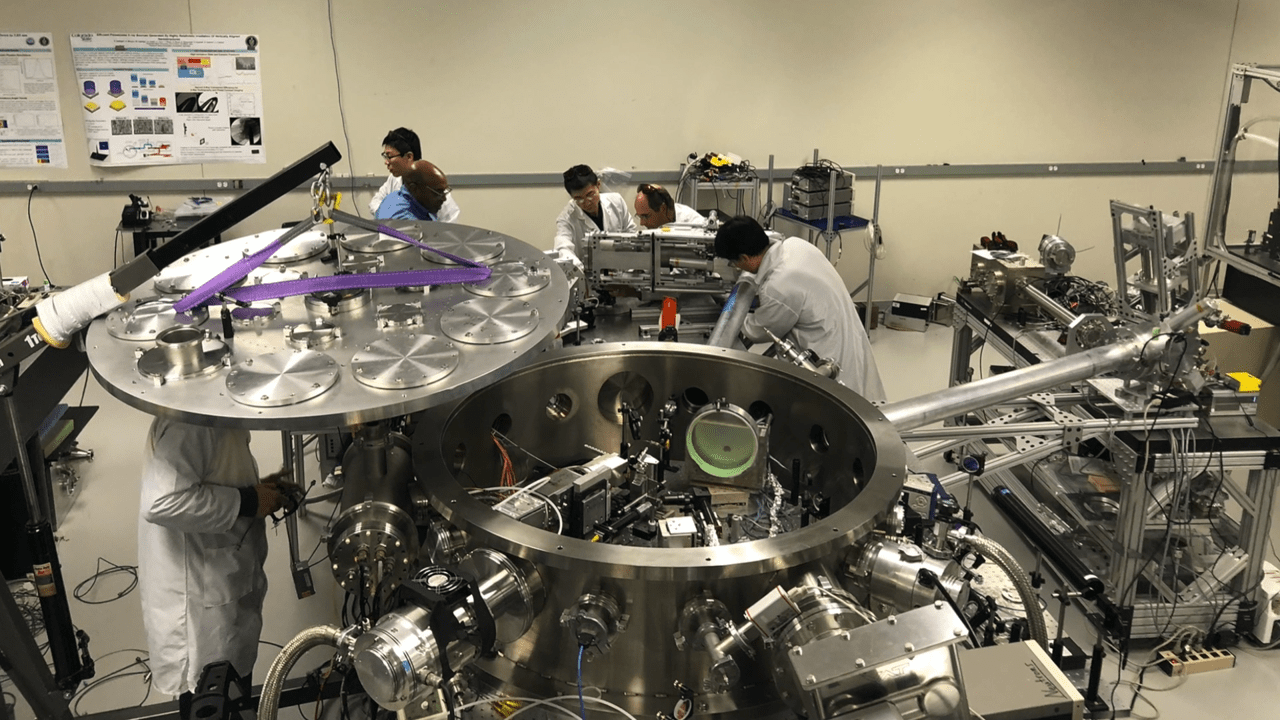Please address
inquiries to:
Advanced Beam Laboratory
Advanced Laser for Extreme Photonics (ALEPH)
- Colorado State University
- Petawatt-Class Laser
- Laser Type: ultra-short pulse Ti:sapphire laser system

Colorado is the #2 state for Technology & Science and the #4 state in concentration of STEM professionals—making it an ideal location for research across a wide range of industries. Based in the scenic foothills of Colorado State University, the ABL combines expertise in accelerator science and technology and advanced high-intensity solid state lasers.
Capabilities

Jorge Rocca
Office: C101E Engineering Building
Phone: 970-491-8371
Email: jorge.rocca@colostate.edu
Read BioOverview
Colorado State University Petawatt-Class Laser is an ultra-short pulse Ti:sapphire laser system that produces ultrahigh-contrast λ = 400 nm femtosecond pulses of up to 10 J, obtained by frequency doubling 800 nm pulses of 45 fs duration. An intensity of 6.5x1021 W/cm2 is obtained focusing the beam with an f/2 parabola. Up to a maximum of 26 J are available at the fundamental wavelength with degraded contrast. A new long focal length f/25 beamline was commissioned in August 2020 and is available to users. Both beamlines can be operated with high contrast = 400nm or with the fundamental. The beam/pulse parameters presently offered by the laser are summarized in the Laser Modes table.
Target Areas
The facility includes a target chamber 1.2m in diameter shown in Figure 2. There are NW 200 and NW 100 located on the equator. A motorized target holder system designed to hold numerous targets and an accurate target positioning system are available. A Solid Works™ generated parasolid model of the target chamber can be downloaded here.
A suite of plasma diagnostics instrumentation is available.
These include:
Plasma Diagnostics instrumentation
A suite of plasma diagnostics instrumentation is available. These include:
- X-ray detection
- Von Hamos crystal spectrometer operating with a 4cm radius of curvature mica crystal covering the 7 keV to 13 keV spectral region
- Filtered silicon photodiode array; filters are available with cut-off between 1 keV and 15 keV
- Step wedge spectrometer
- Ion detection
- Thomson parabola spectrometer with MCP/CCD detector
- Neutron detection
- Array of four scintillator/photomultiplier neutron detectors
- Bubble detectors
A schematic diagram of the laser is shown in Figure 1. It consists of a conventional Ti:Sa front end that delivers λ=800 nm pulses into a chain of three high power Ti:Sa amplification stages pumped by Nd:YAG slab amplifiers. The 250 mJ output of this laser front end is further amplified in three multi-pass Ti:Sa amplifiers pumped by the frequency doubled output of eight compact flash lamp-pumped high energy Nd:glass slab amplifiers, developed at CSU. The slab geometry has long been recognized as a way to significantly reduce the limitations in repetition rate inherent to the more commonly used rod geometry. These pump laser allows Ti:sapphire system operation at a repetition rate of up to 3.3 Hz in burst mode. The beam propagates in a zig-zag path in the gain medium aided by total internal reflection in the polished wall of the slabs eliminating first-order thermal and stress-induced focusing, and also reducing stress-induced birefringence.
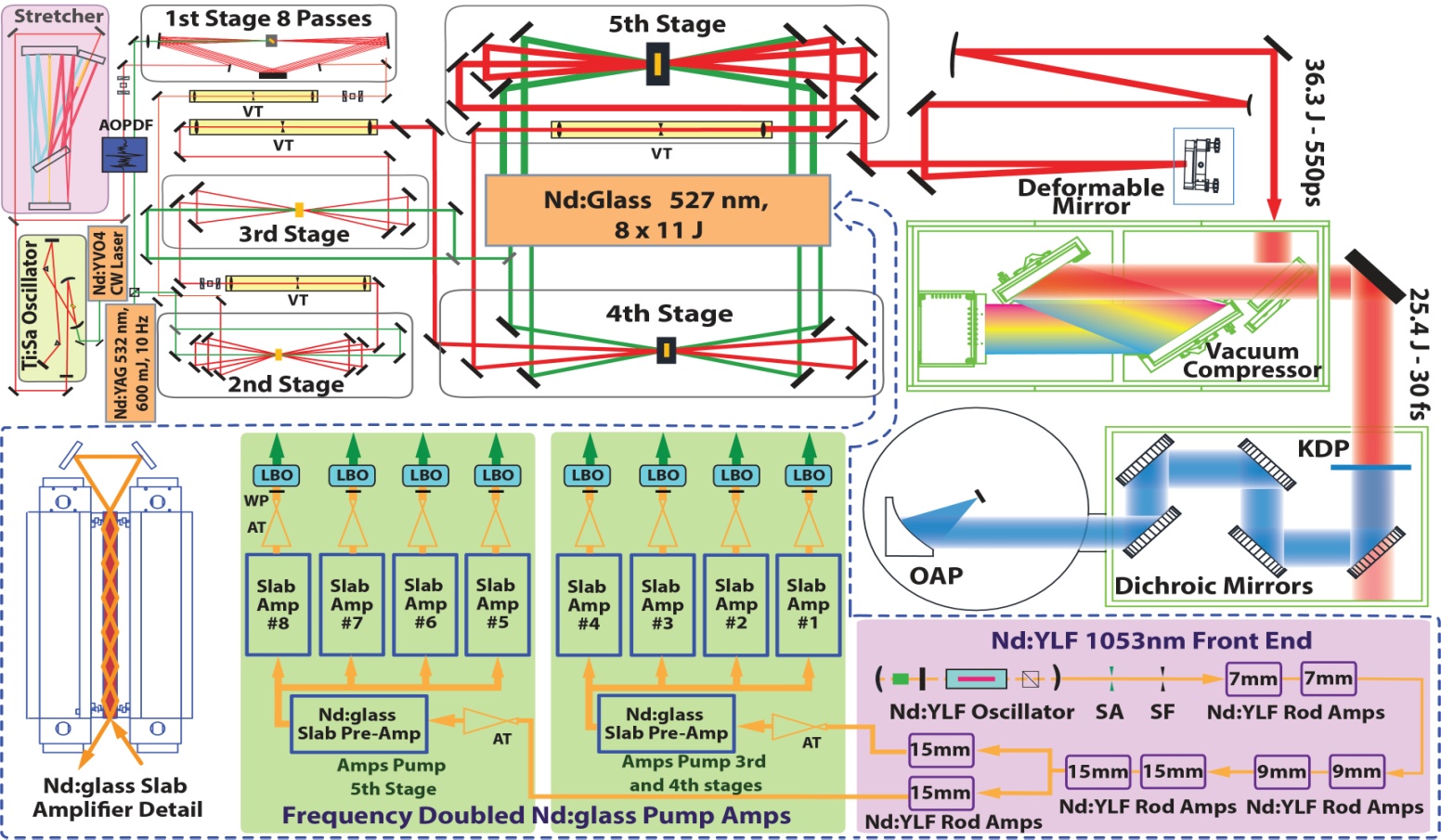
Each slab amplifier generates pulses with ~18 J energy and 15 ns duration at 1053 nm. The rms pulse energy fluctuation for 1053nm slab pump laser is ~1%. The amplified beams are frequency doubled by LBO crystals to generate 11 J pulses at 527 nm. The eight slab amplifier arms produce a total 527 nm pump energy of 88 J, with a uniform nearly flat-top beam profile this is used to pump the three main Ti:Sa amplifiers. The amplifier chain generates 800 nm pulses of up to 37 J energy before compression. A gold grating compressor compresses these pulses into pulses of up to 26 J energy with duration as shot as 30 fs. These pulses are frequency doubled to generate the ultrahigh contrast 400 nm pulses that constitute the normal mode of operation.
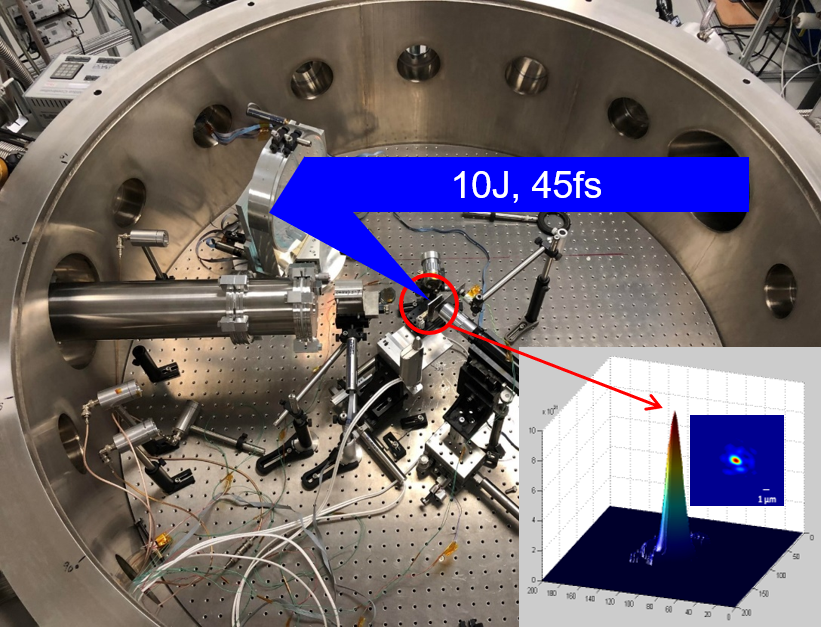
ALEPH 400 nm
| Parameter | Value | Unit | Additional Information | |||
|---|---|---|---|---|---|---|
| Center Wavelength | 400 | nm | ||||
| Pulse duration (I FWHM) | 45 | fs | ||||
| Max energy on target | 10 | J | ||||
| Shot energy stability | 10 | % | r.m.s. | |||
| Focal spot at target | ||||||
| F/number | f/2 | |||||
| intensity FWHM | 1.2 | μm | ||||
| Strehl ratio | ||||||
| Energy containment | 65 | % | within | 1/e | radius | |
| F/number | f/25 | |||||
| focal spot FWHM | 20 | μm | ||||
| Strehl ratio | ||||||
| Energy containment | 70 | % | within | 1/e | radius | |
| Pointing Stability | 2 | μrad | ||||
| Pre-pulse contrast | ||||||
| ps scale | 10-12 | @ >25 ps | ||||
| Repetition Rate | 3.3 | |||||
ALEPH 800 nm
| Parameter | Value | Unit | Additional Information | |||
|---|---|---|---|---|---|---|
| Center Wavelength | 800 | nm | ||||
| Pulse duration (I FWHM) | 30 | fs | ||||
| Max energy on target | 26 | J | ||||
| Shot energy stability | 1.7 | % | r.m.s. | |||
| Focal spot at target | ||||||
| F/number | f/2 | |||||
| intensity FWHM | 2.4 | µm | ||||
| Strehl ratio | ||||||
| Energy containment | 65 | % | within | µm | radius | |
| F/number | f/25 | |||||
| focal spot FWHM | 40 | µm | ||||
| Strehl ratio | ||||||
| Energy containment | 70 | % | within | 1/e | radius | |
| Pointing Stability | 2 | µrad | ||||
| Pre-pulse contrast | ||||||
| ps scale | 5x10-6 | @ > 25 ps | ||||
| Repetition Rate | 3.3 | Hz | burst mode | |||
Contacts
Have a question or need assistance with your research?
News, Events & Publications
